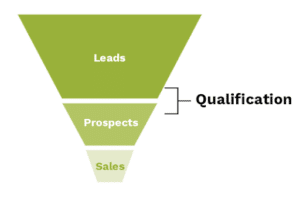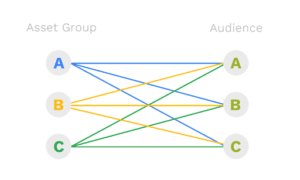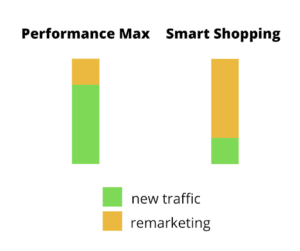Every Friday at 1 PM PST, we host a live Q&A session to help advertisers and business owners navigate Google Ads with clarity and ease.
Lately, we’ve been focusing on answering questions and sharing some of our secret Performance Max strategies and tactics to prepare everyone for the upcoming Smart Shopping-Performance Max transition in the third quarter of 2022.
Here are some of the strategies we pulled from our YouTube LIVE Q&A session:
- How to avoid getting junk traffic or bad leads for lead generation
- How to avoid losing quality impressions
- What bidding strategy works best when launching Performance Max
- How many asset groups you should create
- How to run Performance Max with Smart Shopping
Let’s get started!
How to Avoid Getting Junk Traffic or Bad Leads for Lead Generation

Using lead forms in Performance Max can sometimes lead to getting junk traffic or just plain “bad leads.”
Now, we all want leads. But “bad leads” might not be worth your time and efforts.
So how do you stop getting spammed like crazy? And how do you teach Google to find more of the leads you want?
By pre-qualifying people. And one of the ways to do that is by simply making your forms harder to complete.
See, making your forms harder to complete is like raising your bar for a lead. Chances are, the higher the bar, the better the leads you’ll get.
This allows you to have a filtering method for qualifying your leads.
Once you get conversions, the next thing to do is upload those back into Google Ads.
Then, count those conversion actions inside of Performance Max.
How to Avoid Losing Quality Impressions
One of the common mistakes people make is building out asset groups that are only based on affinity audiences.
An affinity is a permanent picture of the personality of the person that’s in-market. In other words, they are based on users’ interests and habits.
This means a person who’s looking to assemble a DIY office chair can be a part of an affinity audience. Same goes with a person who’s into DIY car cleaning and landscaping.
But what if you’re just looking for those who are in the market for DIY office chairs?
Targeting affinity audiences can often end up targeting people who might not care about your products––thereby affecting the quality of your impressions.
Don’t get me wrong. Affinity audiences are good if you’re targeting broad audiences and clusters of people who might have the same interests and habits. But you shouldn’t focus on them.
When you’re targeting people, don’t target a person based on their affinity unless it’s really relevant.
Here’s what to do instead.
First, when you’re creating asset groups, start with building them out based on your search categories.
Next, build them out based on your in-market audiences.
Then, that’s the time you can start using affinity audiences.
Creating asset groups in this order will help you ensure that you’re targeting the right people and improving the quality of your impressions.
What Bidding Strategy Works Best When Launching Performance Max

We’ve tested all four bidding strategies: target CPA, target ROAS, maximize conversions, and maximize conversion value. And we got better results using maximize conversions and maximize conversion value.
However, maximize conversion value without a target ROAS defaults to 200%.
Here’s why.
If you’re doing this in an existing account, using tCPA or tROAS will attract the audience that Google wants (remarketing or engagement audiences).
If you’re getting choppy results with Performance Max – one day it spends, the next day it doesn’t – you’re probably not using maximize conversions for your bidding strategy.
Whether you’re uploading your own data or giving everything but a very high quality cold traffic signal, it’s going to have that choppiness.
In the beginning, the only bidding strategy that works is maximize conversions. So make sure you start with that bidding. If you’re eCommerce, don’t forget to enable your eComm ProdID and make sure it’s working well.
How Many Asset Groups You Should Create

When you’re starting out, it’s best to create at least 20 asset groups. Instead of creating multiple campaigns, create multiple asset groups:
Then, you’ll want to test your asset groups against different audiences. Here’s what I mean.
Let’s say you have asset groups A, B, and C. Then you have audiences A, B, and C. You’re going to use every variation possible for testing.
So asset group A tested with audience A, B, and C. Then asset group B tested with audience A, B, and C. And so on.
Now, creating those assets takes time. It will probably take 10 to 15 hours (or more) depending on how fast you can do it. Right now, there’s no “automated” way to do it.
The good news is you don’t need to create asset groups from scratch––just duplicate them.
Let’s say you have 10 SKUs. Here’s how you might want to create asset groups.
- Take your first SKU and develop a SKU A asset group. Add images, headlines, videos, and all the assets needed.
- Duplicate that asset group. Then change the name and audience signal as well as the search terms for that SKU. Don’t forget to reselect your products in the listing groups.
- Do this for the other SKUs.
Need a refresher on how to create and duplicate asset groups? Check out our Ultimate Guide to Performance Max blog for the step-by-step tutorial.
You might be thinking, “Doesn’t it require a massive budget to work with all the asset groups?”
Generally speaking, for eCommerce, the minimum budget to effectively run Performance Max is around $100 – $150 per day.
Here’s why.
You’re equally distributing your budget to YouTube, GSP, Display, Discovery, Shopping, Search, and potentially a local campaign. So if your budget is $100 per day, you’re spending roughly $14 for each campaign.
Now, depending on the signal, Google is going to prioritize Display. The way to counter that is to do this simple Performance Max hack we came up with.
How to Run Performance Max With Smart Shopping
If you’re running Smart Shopping and switched to Performance Max, you might have noticed you’re not getting as many impressions anymore.
That happens because when you launch Performance Max, you’re ignoring your previous audience.

Remember, Smart Shopping is 80% remarketing and 20% new customer traffic. Performance Max is 80% new customer traffic and 20% remarketing.
So if you paused the Smart Shopping campaign and launched Performance Max, those people that have been remarketed to won’t be carried over.
The standard operating procedure we use is this:
Launch Performance Max with Smart Shopping at the same time, with the same daily ad spend.
You’ll see Smart Shopping drop because the dynamic remarketing is still finishing its job–it’s not getting new customers and not being targeted by Performance Max. And that’s okay.
It’s still going to work on remarketing those people until that audience just fades away. But your Performance Max will start off well for customer acquisition.
Need more strategies?
This coming July 2022, Performance Max is set to replace Smart Shopping and local campaigns. That’s why it’s important to understand how Performance Max works.
If you want to stay ahead of the game, check out our YouTube channel to learn more about Performance Max. Just click on the link below to subscribe!
Author
Bryan is the marketing manager at Solutions 8, and has been on digital marketing since 2018. When he’s not working, you’ll find him working out at a local gym, reading personal development books, or playing music at home. He feels weird writing about himself in third person.
 Bryan Caranto
Bryan Caranto











